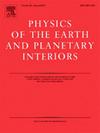青藏高原东北缘地壳变形特征及其构造意义
IF 1.9
3区 地球科学
Q2 GEOCHEMISTRY & GEOPHYSICS
引用次数: 0
摘要
本研究利用青藏高原东北缘50个便携式台站和38个常设台站的连续波形数据。利用环境噪声相互关联,获得周期为1 ~ 35s的瑞利波相速度,并对这些数据进行反演,得到三维方位各向异性横波速度模型。结果表明,研究区内的方位各向异性特征具有明显的分带性。以海原-六盘山断裂带为分界,鄂尔多斯地块东部浅层地壳受沉积层影响,各向异性弱,以快波方向为北向;在中下地壳,快波方向为NE向。在西侧,浅层地壳呈现与区域构造走向一致的快波方向。受区域主构造应力影响,中、下地壳主要呈现NE-SW(主要分布在海原断裂带东端)和NWW-SEE(主要分布在北秦岭断裂带北侧)两个快波方向。这两个不同的方向导致了海源断裂带的左旋走滑运动和隆中盆地的顺时针旋转。平均方位角各向异性结果显示青藏高原东北缘浅部受到明显的构造影响,海原-六盘山地区深快波方向一致,可能存在耦合变形机制。北秦岭断裂带45 km左右各向异性振幅和快波方向变化明显,表明上下地壳存在解耦层和不连续变形机制。本文章由计算机程序翻译,如有差异,请以英文原文为准。

Crustal deformation characteristics and tectonic implications on the northeastern margin of the Tibetan Plateau
This study utilizes continuous waveform data from 50 portable stations and 38 permanent stations deployed on the northeastern margin of the Tibetan Plateau. Using ambient noise cross-correlation, we obtained Rayleigh wave phase velocities for periods ranging from 1 to 35 s and subsequently inverted these data to obtain the 3D azimuthally anisotropic shear wave velocity model. The results indicate a clear zonation of azimuthal anisotropy characteristics within the study area. Using the Haiyuan-Liupanshan fault zone as the dividing line, the shallow crust of the eastern Ordos block exhibits weak anisotropy due to sedimentary layer, with fast wave direction-oriented NS. In the middle and lower crust, the fast wave directions are oriented NE. On the western side, the shallow crust exhibits fast wave directions consistent with the regional tectonic orientations. The middle and lower crust exhibits two dominant fast wave directions influenced by regional principal tectonic stress: NE-SW, primarily distributed at the eastern end of the Haiyuan fault zone, and NWW-SEE, mainly found near the northern side of the North Qinling fault zone. These two differing directions result in the left-lateral strike-slip movement of the Haiyuan fault zone and the clockwise rotation of the Longzhong Basin. The average azimuthal anisotropy results show significant tectonic influence on the shallow parts of the northeastern margin of the Tibetan Plateau, with consistent deep fast wave directions in the Haiyuan-Liupanshan area, suggesting a possible coupling deformation mechanism. The North Qinling fault zone area shows significant changes in anisotropy amplitude and fast wave directions around 45 km depth, indicating a decoupling layer and discontinuous deformation mechanisms between the upper and lower crust.
求助全文
通过发布文献求助,成功后即可免费获取论文全文。
去求助
来源期刊

Physics of the Earth and Planetary Interiors
地学天文-地球化学与地球物理
CiteScore
5.00
自引率
4.30%
发文量
78
审稿时长
18.5 weeks
期刊介绍:
Launched in 1968 to fill the need for an international journal in the field of planetary physics, geodesy and geophysics, Physics of the Earth and Planetary Interiors has now grown to become important reading matter for all geophysicists. It is the only journal to be entirely devoted to the physical and chemical processes of planetary interiors.
Original research papers, review articles, short communications and book reviews are all published on a regular basis; and from time to time special issues of the journal are devoted to the publication of the proceedings of symposia and congresses which the editors feel will be of particular interest to the reader.
 求助内容:
求助内容: 应助结果提醒方式:
应助结果提醒方式:


